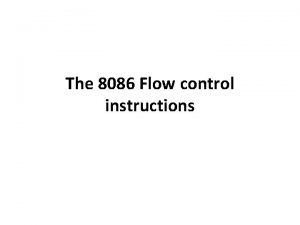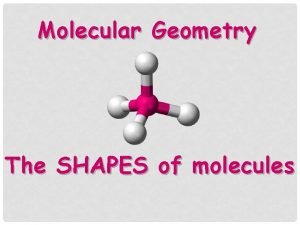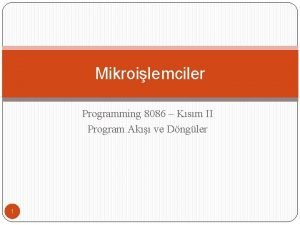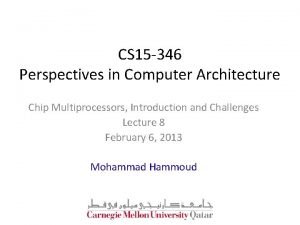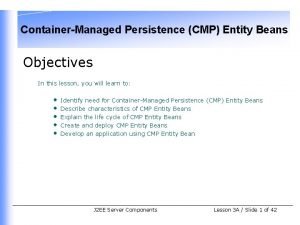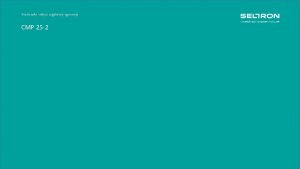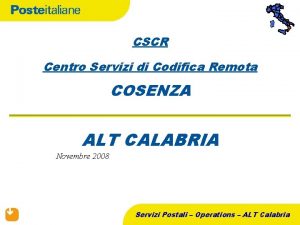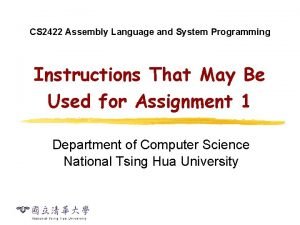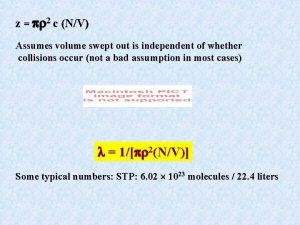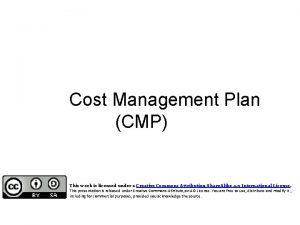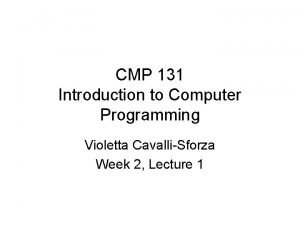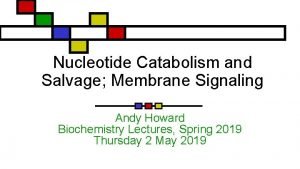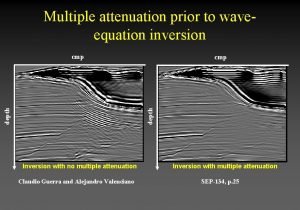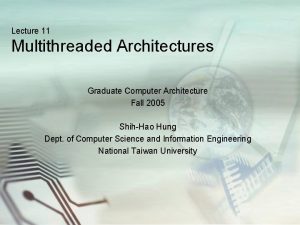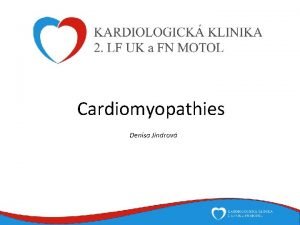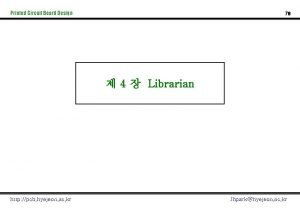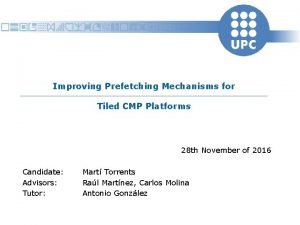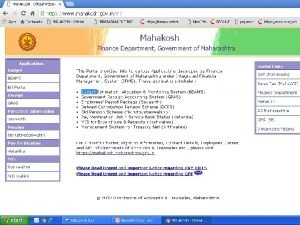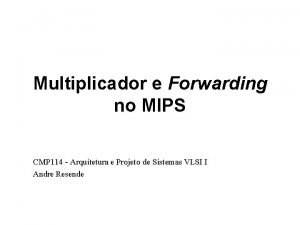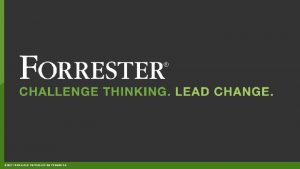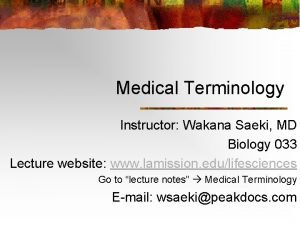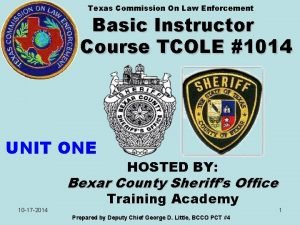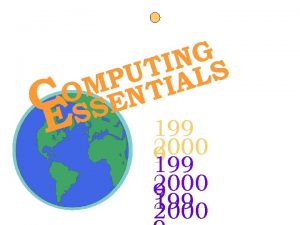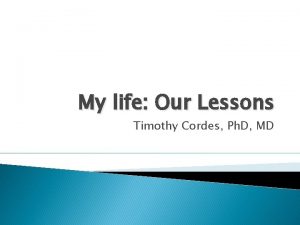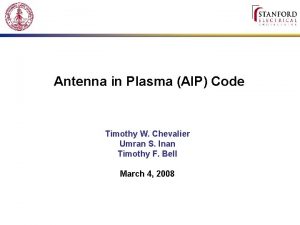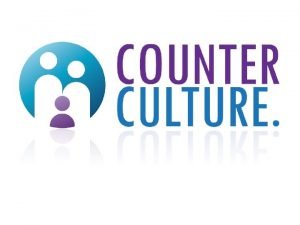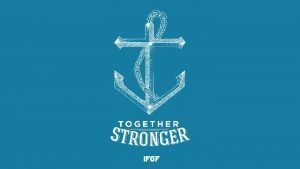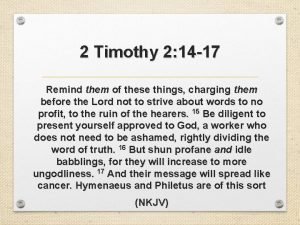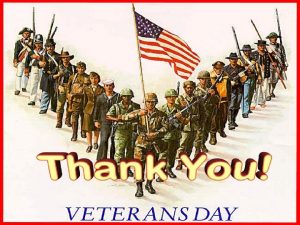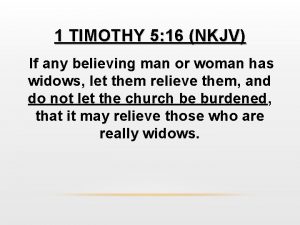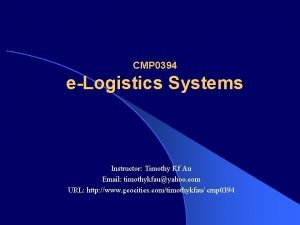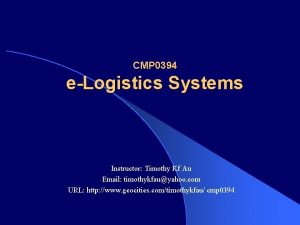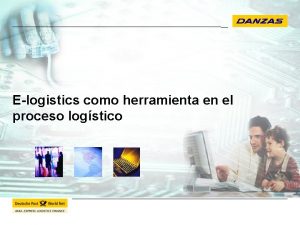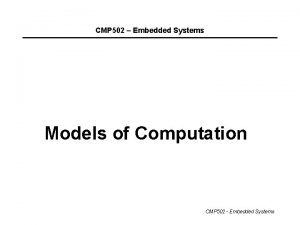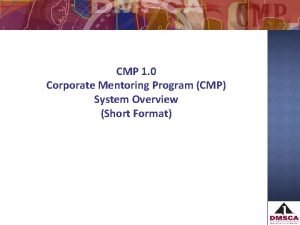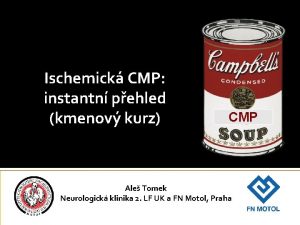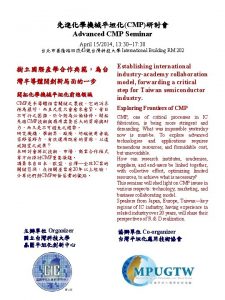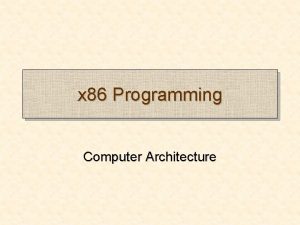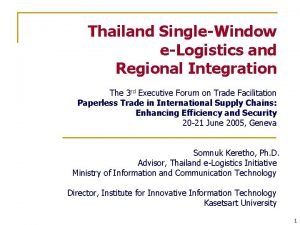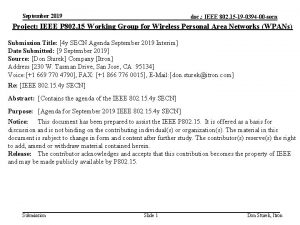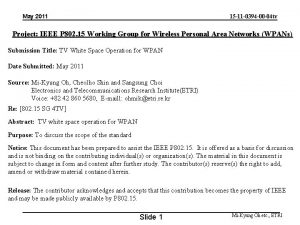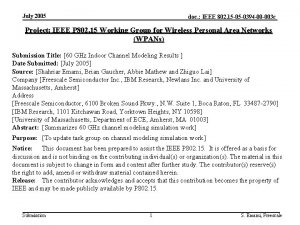CMP 0394 eLogistics Systems Instructor Timothy Kf Au


![Computer Networks l What is a Network? [In the context of information technology] – Computer Networks l What is a Network? [In the context of information technology] –](https://slidetodoc.com/presentation_image_h2/712db080b1821625d6ccd88c931c00b2/image-3.jpg)









































![Internetworking [Network Layer] Up to now, we have implicitly assumed there is a single Internetworking [Network Layer] Up to now, we have implicitly assumed there is a single](https://slidetodoc.com/presentation_image_h2/712db080b1821625d6ccd88c931c00b2/image-45.jpg)
















































- Slides: 93

CMP 0394 e-Logistics Systems Instructor: Timothy Kf Au Email: timothykfau@yahoo. com URL: http: //www. geocities. com/timothykfau/ cmp 0394

Chapter 8 Design for e-Logistics: Networking and Applications to e-Logistics 8. – – – – Local Area Network (LAN) Architecture LAN Components LAN Design Considerations Wide Area Network (WAN) Automated Data Collection Barcoding system Radio Frequency Systems 2
![Computer Networks l What is a Network In the context of information technology Computer Networks l What is a Network? [In the context of information technology] –](https://slidetodoc.com/presentation_image_h2/712db080b1821625d6ccd88c931c00b2/image-3.jpg)
Computer Networks l What is a Network? [In the context of information technology] – a network is a series of points or nodes interconnected by communication paths. Networks can interconnect with other networks and contain subnetworks. – local area networks (LAN) – a few km – metropolitan area networks (MAN) - 10 km – wide area networks (WAN) - across geographical boundaries 3

Computer Networks l Uses of Computer Networks – – – – Fax Email Online Game Video Conference Net Meeting ICQ FTP Telnet Gopher WWW SMS Newsgroup MMS 4

Computer Networks l Uses of Computer Networks – – – – Forum Instant Message MSN Messenger Yahoo! Messenger Internet Phone Home Entertainment VOD e-Business e-Banking e-Learning e-Logistics e-Marketing e-Trading Online Shopping 5

Examples of Computer Networks l l l l The Internet Novell Netware X. 25 Frame Relay ATM Ethernet: 802. 3 Wireless LAN: 802. 11 Wireless MAN: 802. 16 6

Examples of Computer Networks l l l l l ITU V. 32, V. 34 T 1, T 2, T 3, E 1 ISDN, SONET ITU H. 323 Broadband ADSL, x. DSL, Cable Modem, CDMA, TDMA, FDMA, GPRS, GSM, 2 G, 2. 5 G, 2. 75 G, 3 G 7

Local Area Network (LAN) Local Area Networks (LANs) are privately owned networks; l Within a single building or campus of up to a few km in size; l Used in connecting PCs and workstations in company offices and factories to share resources including hardware (e. g. printer) and software (e. g. application program) or information; l Usually not provided by public telephone operators and separated by firewall for security l 8

Local Area Network (LAN) LANs are distinguished from other kinds of networks by THREE characteristics: l their size; l their transmission technology; l their topology. l 9

Local Area Network (LAN) l LANs are restricted in size. – This means that the worst case transmission time is bounded and known in advance. – Knowing this bound makes it possible to use certain kinds of designs that otherwise would not be possible. – It also simplifies network management. 10

Local Area Network (LAN) l Transmission technology – LANs often use a transmission technology consists of a single cable to which all machines are attached. – Traditional LANs run speeds of 10 Mbps to 100 Mbps. – Have low delay (tens of microseconds), and very few errors. – Newer LANs operate at higher speed, Gigabtype Ethernet (Gb. E) 11

Local Area Network (LAN) Architecture l There are several common topologies: – Bus – Star – Ring – Token Ring – Mesh – Tree 12

Local Area Network (LAN) Architecture l LAN Topologies – The way in which the connections are made among all computers – Network topology specifically refers to the physical layout of the network, – specially the location of the computers and how the cable run between them – The topology diagram shown is made up of LAN workstations, also called nodes. The lines between these nodes represent cables. 13

Network Components l The most common components of a computer network are: – – – – Terminal Workstation Server NIC (Network Interface Card) NTU (Network Terminating Unit) Communication Media Network Operating System Backbone 14

Network Components l Terminal – In data communications, a terminal is any device that terminates one end (sender or receiver) of a communicated signal. – Types of Terminal – – – DTE (Data Terminal Equipment) DCE (Data Communication Equipment) "Dumb" Terminal "Intelligent" terminal Network computer (NC) Graphical terminal 15

Network Components l Other Examples of Terminal – POS Terminal – ATM Terminal – AMS/3 Terminal 16

Network Components l Workstation – A workstation is a computer intended for individual use that is faster and more capable than a personal computer. – In today's corporate environments, it simply means personal computer attached to a local area network (LAN) 17

Network Components l Server – In general, a server is a computer program that provides services to other computer programs in the same or other computers. – In the client/server programming model, a server is a program that awaits and fulfills requests from client programs in the same or other computers. – For instance, a Web server is the computer program usually hosted in a computer that serves requested HTML pages or files. 18

Network Components l Types of Server – File Server – Database Server – Printer Server – Disk Server – LAN Server – Web Server – Application Server – Enterprise Server 19

Network Components l Types of Server – Terminal Server – Remote Access Server – Firewall Server – DNS Server – Proxy Server – Mail Server – Fax Server – AAA Server 20

Network Components l NIC – A network interface card (NIC) is a computer circuit board or card that is installed in a computer so that it can be connected to a network. – Personal computers and workstations on a local area network (LAN) typically contain a network interface card 21

Network Components l NTU – In a normal configuration for a small using the Integrated Services Digital Network (ISDN), the carrier must place a network terminating unit, an NT 1 on customer's premises and connects it to the ISDN exchange in the carrier exchange. – For a large corporate, more traffic to be handled simultaneously. An NT 2, called a PBX (Private Branch e. Xchange) is connected to NT 1. 22

Network Components l Communication Media – Telecommunications is the transfer of information across a distance. – The information, in its native form, can be voice or other forms of audio, computer data, facsimile or other forms of image, video or even multimedia. – There must be a transmitter, or originating device, and at least one receiver, or destination device. Supporting the transmission must be some physical medium, with physical referring to physics and not necessarily to anything tangible. 23

Network Components l Communication Media – Guided Transmission Media Coaxial Cable, Twisted Pair, Shielded twisted pair, - Shielded twisted pair (STP) and Unshielded twisted pair (UTP) Fiber Optics – Unguided Transmission Media – Microwave, Satellite, Radio Wave Frequency Infrared (IRF) – Transmission Impairments. Attenuation, Delay Distortion and Noise 24

Network Components l Physical Layer – Guided Transmission media – Coaxial cable – UTP (Unshielded Twisted pair) – STP (Shielded Twisted pair) – Optical fibre 25

Network Components l Coaxial Cable – Coaxial cable is the kind of copper cable with one physical channel that carries the signal surrounded by a layer of insulation material. 26

Network Components l UTP – UTP consists of a number of twisted pairs. – Because economic in price, adequate performance and easy installation, it is most commonly used today. – 10 Mbps, 100 Mbps Outer Jacket Copper wire Insulation Twisted pair 27

Network Components l STP – STP includes shields to reduce crosstalk and EMI (electromagnetic interference) – Not commonly used except IBM installation – Relatively low speed 4 Mbps, 16 Mbps 28

Network Components l Optical fiber – Optical fiber (or "fiber optic") refers to the medium and the technology associated with the transmission of information as light pulses along a glass or plastic wire or fiber. – Optical fiber carries much more information than conventional copper wire and is in general not subject to electromagnetic interference and the need to retransmit signals. – Most telephone company long-distance lines are now of optical fiber. 29

Network Components l Physical Layer – Unguided Transmission media has no physical link between sender and receiver – Microwave – Satellite – Radio Wave Frequency (RF) – Infrared (IRF) 30

Network Components l Microwave – Waves travel in straight lines at above 100 MHz and therefore be narrowly focused. – Transmitting and receiving antenna must be aligned very accurately – Since microwaves travel in straight line, if the towers are too far apart, farther travels are stopped by the curvature of the earth – The higher the towers are, the farther distance they can be; low hills and tall buildings block transmission 31

Network Components l Line of sight – Because waves travel in straight line, receiver’s antenna may not "see" another because of the earth's curvature. – propagating of microwave does not follow the earth's surface. Line of sight communication has the transmitter and receiver antennas in visual contact with each other. – This directing of our sight in a specific direction is sometimes referred to as the line of sight. 32

Network Components l Microwave – Since microware signal is unidirectional – Two frequencies are needed: transmit and receive. – Each frequency needs a transmitter and receiver. – Today, they are combined into a single equipment transceiver which allows single antenna to serve both frequencies – Terrestrial microwave is used when cabling is costly and difficult to set 33

Network Components l Satellite – Similar to terrestrial microwave – Signals must travel in straight lines – A communication satellite can be thought of a large microwave repeater in the sky – Limitation of the curvature of the earth is reduced – Provide transmission capability to and from any location on the earth no matter how remote 34

Network Components l Radio Wave Frequency – Can travel long distances and penetrate buildings – Widely used in communications both indoor and outdoor – Radio waves are omni directional – they travel in all directions from the source; such that the transmitter do have need to be align physically with the receiver – Due to the ability of RF to travel long distance, governments license users of radio transmitters - FCC regulation (OFTA in Hong ) 35

Network Components l Infrared – LEDs (Light emitting diode) transmit signals and photodiodes – – – receive the signal Transmission media is Infrared light Often used by the remote control in VCD, DVD players Because high frequency range, IRF have good throughput Cannot penetrate wall and solid object; and strongly diluted in strong sunlight Directional, cheap, easy to install Suitable for indoor wireless LAN 36

Network Components l Cellular communication – – – – Paging Systems Cordless Phones AMPS (Advanced Mobile Phone Service) TACS (Total Access Communication System). CDMA (Code Division Multiple Access) TDMA (Time Division Multiple Access) FDMA (Frequency Division Multiple Access) – GSM (Global Systems for Mobile Communications) 900 MHz, 1800 Mhz – PCS (Personal Communications Services) 37

Network Components 2. 5 G – GPRS (General Packet Radio Services) l 3 G – UMTS (Universal Mobile Telecommunications Service) – EDGE (Enhanced Data GSM Environment) l l 4 G ? 38

Network Components l Network Operating System – A network operating system (NOS) is a computer operating system that is designed primarily to support workstation, personal computer, and, in some instances, older terminal that are connected on a local area network (LAN). – Artisoft's LANtastic, Banyan VINES, Novell's Net. Ware, and Microsoft's LAN Manager are examples of network operating systems. 39

Network Components l Backbone – A backbone is a larger transmission line that carries data gathered from smaller lines that interconnect with it. – At the local level, a backbone is a line or set of lines that local area networks connect to for a wide area network. – On the Internet or other wide area network, a backbone is a set of paths that local or regional networks connect to for long-distance interconnection. 40

LAN Design Considerations l Dedicated or nondedicated server – – l Sharing of resources – l l l Non-dedicated Server – A computer that runs standard programs and lets other users to see its data at the same time, can clever enough to set up small LAN without any extra system. Dedicated Server – A computer specially assigned for network management and provides no general purpose services. Sharing of resources including computing power, software, input and output units Sharing of information Cost installation and maintenance Administration staff and skills Vulnerable to security threats Data Privacy 41

Virtual LAN (VLAN) l Virtual LAN (VLAN) – A virtual (or logical) LAN is a local area network with a definition that maps workstations on some other basis than geographic location. – The virtual LAN controller can change or add workstations and manage load balancing and bandwidth allocation more easily than with a physical picture of the LAN. – Network management software keeps track of relating the virtual picture of the local area network with the actual physical picture. 42

Metropolitan Area Networks (MANs) l Metropolitan Area Networks (MANs) are basically bigger than LAN and normally use similar technology. l It may cover a group of nearby corporate offices or a city and might be either private or public. l A MAN can support both data and voice, and might also be cable television (CATV) network. l It may be a means of connecting a number of LANs into a larger network so that resources maybe shared LAN-to. LAN and device-to-device. l A MAN may be operated by private or public company. 43

Wide Area Network (WAN) l l l A wide area network (WAN) spans a large geographical area, often a country or continent. It contains a collection of machines intended for running user applications. Long distance transmission of data, voice, image and video information. In contrast to LANs, WANs may utilize public, leased or private communication devices, usually in communications and can therefore span over an unlimited number of miles. A WAN that is wholly owned and used by a single company is often referred to as an Enterprise Network. 44
![Internetworking Network Layer Up to now we have implicitly assumed there is a single Internetworking [Network Layer] Up to now, we have implicitly assumed there is a single](https://slidetodoc.com/presentation_image_h2/712db080b1821625d6ccd88c931c00b2/image-45.jpg)
Internetworking [Network Layer] Up to now, we have implicitly assumed there is a single homogenous network, l With each machine using the same protocol in each layer. l Unfortunately, this is too optimistic. Many different types of networks exist including LANs, MANs and WANs. l Numerous protocols are in widespread use in every layer. l 45

Internetworking l l l Many networks exist in the world, different hardware and software. people connected to different networks want to communicate with each other. incompatible networks connected and operable together usually by a machine called gateway. The work of the gateway is to make the connection and provide the necessary translation in terms of hardware and software. A collection of interconnected networks often refers to internetwork or internet. 46

The Internet Two or more networks are connected together to form an internet. l lowercase internet versus Uppercase the Internet which is the worldwide system of computer networks. l 47

The Internet l It was conceived by the Advanced Research Projects Agency (ARPA) of the U. S. government in 1969 and was first known as the ARPANET. l Technically, what distinguishes the Internet is its use of a set of protocols called TCP/IP (for Transmission Control Protocol/Internet Protocol) l The most widely used part of the Internet is the World Wide Web (often abbreviated "WWW" or called "the Web"). Its outstanding feature is hypertext, and the Hyper. Text Markup Language (HTML). l Using the Web, you have access to millions of pages of information. Web browsing is done with a Web browser, the most popular of which are Microsoft Internet Explorer and Netscape Navigator 48

Networking and Internetworking Devices l Networking means connecting two or more devices for the purpose of sharing data and resources. 49

Networking and Internetworking Devices Networking Devices l Repeater, l Hub, l Bridge, Internetworking Devices l Router, l Brouter, l Switch, l Gateway, 50

Networking and Internetworking Devices l l l l Concentrator, Multiplexer, Modem NIC VPN Firewall Storage Devices DAS SAN NAS 51

Repeater (中繼器) l A repeater is a physical device that receives, amplifies and retransmits signal in both directions. l As far as software is concerned, a series of cable segments connected by repeaters is no different than a single cable. l 5 -4 -3 rule. Between any two nodes on the network, there can only be a maximum of five segments, connected through four repeaters, or concentrators, and only three of the five segments may contain user connections. 52

Hub (集線器) l A hub is a place of convergence where data arrives from one or more directions and is forwarded out in one or more other directions. l A hub usually includes a switch of some kind. (And a product that is called a "switch" could usually be considered a hub as well. ) l The distinction seems to be that the hub is the place where data comes together and the switch is what determines how and where data is forwarded from the place where data comes together. 53

Bridge (橋接器) l l l (也稱網橋) A bridge is device used to interconnect multiple LANs that use the same protocol (e. g. Ethernet or Token Ring) to form an extended LAN. It is a Store and-forward device. 54

Router (路由器) l On the Internet, a router is a device or, in some cases, software in a computer, that determines the next network point to which a packet should be forwarded toward its destination. 55

Router l The router is connected to at least two networks and decides which way to send each information packet based on its current understanding of the state of the networks it is connected to. l A router may create or maintain a routing table of the available routs and their costs to determine the best route for a given packet. l Routing is a function associated with the Network Layer (layer 3) in the ISO Reference Model. 56

Routing Table l. A routing table contains the network addresses and the addresses of routers that handle those networks. l Static Routing l Dynamic Routing 57

Brouter A bridging router (brouter) operates as a router and bridge. It combines the dynamic routing capabilities of an internetwork router with the features of a bridge to interconnect different LAN’s. l Operating at the Network and Data Link Layers of the OSI Reference Model, a brouter can route one or more protocols, routing some to other subnets, while bridging the remainder of the protocols. l 58

Switch (交換器) l A device that filters and forwards packets between LAN segments. l LANs that use switches to join segments are called switched LANs or, in the case of Ethernet networks, switched Ethernet LANs. l Switches operate at the data link layer (layer 2) and sometimes the network layer (layer 3) of the OSI Reference Model and therefore support any packet protocol. 59

Switch l A switch performs the layer 2 or Data-Link layer of the OSI Reference Model. That is, it simply looks at each packet or data unit and determines from a physical address (the "MAC address") which device a data unit is intended for and switches it out toward that device. l Some newer switches also perform routing functions (layer 3 or the Network Layer in OSI) and are sometimes called IP switches. 60

Switching Hub l a special type of hub that forwards packets to the appropriate port based on the packet's address. l Conventional hubs simply rebroadcast every packet to every port. Since switching hubs forward each packet only to the required port, they provide much better performance. l Most switching hubs also support load balancing, so that ports are dynamically reassigned to different LAN segments based on traffic patterns. 61

Gateway (閘) l A gateway is a network point that acts as an entrance to another network. In enterprises, the gateway is the computer that routes the traffic from a workstation to the outside network that is serving the Web pages. In homes, the gateway is the ISP that connects the user to the internet. l In enterprises, the gateway node often acts as a proxy server and a firewall. The gateway is also associated with both a router, which use headers and forwarding tables to determine where packets are sent, and a switch, which provides the actual path for the packet in and out of the gateway. l 62

Multiplexer A communications device that multiplexes (combines) several signals for transmission over a single medium. l A demultiplexor completes the process by separating multiplexed signals from a transmission line. l Frequently a multiplexor and demultiplexor are combined into a single device capable of processing both outgoing and incoming signals. l Also known as mux or multiplexor. l 63

Concentrator l A type of multiplexer that combines multiple channels onto a single transmission medium in such a way that all the individual channels can be simultaneously active. l For example, ISPs use concentrators to combine their dial-up modem connections onto faster T-1 lines that connect to the Internet. l Concentrators are also used in local-area networks (LANs) to combine transmissions from a cluster of nodes. In this case, the concentrator is often called a hub or MAU (Media Access Unit). 64

Modem (數據機) (也稱 調制解調器) l Modem is a short form of modulator-demodulator. A modem modulates outgoing digital signals from a computer or other digital device to analog signals for a conventional copper twisted pair telephone line and demodulates the incoming analog signal and converts it to a digital signal for the digital device. l There is one standard interface for connecting external modems to computers called RS-232. Consequently, any external modem can be attached to any computer that has an RS-232 port. l 65

Broadband modem l Cable modem l ADSL modem l ISDN modem 66

Cable modem l The modem we have introduced before are used for processing analogy signal in public telephone network. Cable modem is designed for processing signal from CATV. A cable modem is a device that enables you to hook up your PC to a local cable TV line. A cable modem can be added to or integrated with a set-top box that provides your TV set with channels for Internet access. l A cable modem has two connections: one to the cable wall outlet and the other to a PC or to a set-top box for a TV set. l 67

ADSL l ADSL (Asymmetric Digital Subscriber Line) is a new technology for transmitting digital information at a high bandwidth on existing phone lines to homes and businesses. l ADSL provides continously-available, "always on" connection. ADSL is asymmetric in that it uses most of the channel to receiving data 1. 5 M ~ 6 M (known as the downstream) to the user and only a small part to sending data 16 K ~ 640 K (known as the upstream ) from the user. 68

ADSL modem ADSL requires a special ADSL modem. Also known as ATU-R (ADSL Terminal Unit – Remote) l ADSL modem is a hardware unit that is installed in any computer that uses a telephone company connection with Asymmetric Digital Subscriber Line (ADSL) service. l ADSL modem connects to an Ethernet network interface card (NIC) in the computer and, on the other side, to a telephone jack in the home or business. l The splitter divides the signal into low frequencies for voice and high frequencies for data. l 69

ISDN l l l Abbreviation of integrated services digital network, an international communications standard for sending voice, video, and data over digital telephone lines or normal telephone wires. ISDN supports data transfer rates of 64 Kbps (64, 000 bits per second). There are two types of ISDN: Basic Rate (BRI) ISDN - consists of two 64 -Kbps B-channels and one D-channel for transmitting control information. Primary Rate ISDN - consists of 23 B-channels and one D-channel (U. S. ) or 30 B-channels and one D-channel (Europe). The original version of ISDN employs baseband transmission. Another version, called B-ISDN, uses broadband transmission and is able to support transmission rates of 1. 5 Mbps. B-ISDN requires fiber optic cables and is not widely available. 70

ISDN modem ISDN requires special ISDN modem is a hardware unit that is installed in any computer that uses a telephone company connection with ISDN service. l 71

NIC (網路卡) l Interface Card or Adapter Network Interface Card (NIC) l A network interface card (NIC) is a computer circuit board or card that is installed in a computer so that it can be connected to a network. l Personal computers and workstations on a local area network (LAN) typically contain a network interface card 72

NIC Types of NIC connectors l BNC (British Naval Connector or Bayonet Nut Connector or Bayonet Neill Concelman) l AUI (Attachment Unit Interface) l RJ-45 (Registered Jack-45) l … 73

NIC Other types of interfaces: l l l Serial Parallel Keyboard, PS 2 mouse, monitor KVM (Keyboard, Video, Mouse) switches COM (RS-232) IDE (Integrated Drive Electronics) PCI (Peripheral Component Interconnect) SCSI (Small Computer System Interface) USB (Universal Serial Bus) PCMCIA (Personal Computer Memory Card International Association) Firewire (IEE 1394) Fibre Channel 74

VPN (虛擬專用網) l A virtual private network (VPN) is a way to use a public telecommunication infrastructure, such as the Internet, to provide remote offices or individual users with secure access to their organization's network. l The VPN devices can be either a computer running VPN software or a special device like a VPN enabled router. It allows your home computer to be connected to your office network or can allow two home computers in different locations to connect to each over the Internet. l VPN Servers was very expensive until recently. Nowadays, Broadband router includes VPN router functions. 75

Firewall (防火牆) l A firewall is a set of related programs that protects the resources of a private network from users from other networks. 76

Storage Devices DASD (Direct Access Storage Device) l SAN (Storage Area Network) l NAS (Network-Attached Storage ) l 77

Automated Data Collection l Automated Data Collection – – – Screen capture, Video, Audio, Keystroke recording Measuring System Handled scanner Mobile device and Wireless communications Applications – – Electronic form Workflow Electronic Distribution and Warehouse mangement Retail Back office and POS 78

Barcoding system l Barcoding system – EAN. UCC Barcode Standards – Area of Applications EAN/UPC Symbology l ITF-14 Symbology l UCC/EAN-128 Symbology l 79

Barcoding system l What are barcodes? – Barcodes are usually prepared in the production process at the producer site. – They are either pre-printed with other information present in the packaging, or a label is affixed on the item at the production line. 80

Barcoding system l Area of Applications – Global Trade Item Number(GTIN) for trade items – Serial Shipping Container Code (SSCC) for logistics units – Global Returnable Asset Identifier (GRAI) and – Global Individual Asset Identifier (GIAI) for returnable and internal individual assets respectively and – Global Location Number (GLN) for locations. l The numbers are represented in bar codes to allow automatic data capture at each point where an item leaves or enter premises (usually warehouse or distribution centers along the supply chain not the POS. 81

Barcoding system l l l ITF-14 and EAN/UPC – EAN-13 – EAN-8 – UPC-A – UPC-E UCC/EAN-128, Reduced Space Symbology (RSS) and EAN. UCC Composite Symbology (2 -Dimension barcode) standard barcodes endorsed by the EAN. UCC which provide secure system for automatic data capture, avoid fraud and ambiguous meaning throughout the supply chain. 82

Barcoding system l ITF-14 – The use of the ITF-14 (Interleaved Two of Five or I 2 of 5) symbology is intended to be marked on the items identified in EAN/UCC-14 GTIN structure which does not have a likelihood to be scanned at the retail checkouts. – This symbology is better suited for direct printing onto corrugated [uneven, grooved, wavy] fibreboard. 83

Barcoding system l UCC/EAN Symbology – EAN/UPC Symbology is marked on the items which are intended to be scanned at the retail point of sale. – There are 4 types of barcode format under the umbrella name of EAN/UPC symbology: l l EAN-13 representing GTIN number structure of EAN/UCC-13, EAN-8 representing EAN/UCC-8, UPC-A and UPC-E representing UCC-12 in 12 digits and zerosuppressed format respectively. 84

Barcoding system UCC/EAN Symbology EAN-13 UPC-A EAN-8 UCC/EAN-E 85

Barcoding system l UCC/EAN-128 – The UCC/EAN-128 symbology is a variant of Code 128 symbology. Its use is exclusively licensed to EAN International and Uniform Code Council (UCC). It is not intended to be read on items passing through retail checkouts. This is the only EAN/UCC endorsed symbology that allows the encoding Application Identifier (AI) data which AI provides the techniques to add supplementary information (such as batch number, serial number, data, etc) in additional to identification numbers. 86

Barcoding system l UCC/EAN-128 format – – – – a light margin a start character A, B or C a FNC 1 character Data (Application Identifier + data field) a symbol check character a stop character a light margin Reference: http: //www. ean-int. org 87

Auto. ID l What is automatic identification? – Automatic identification, or auto ID for short, is the broad term given to a host of technologies that are used to help machines identify objects. Auto identification is often coupled with automatic data capture. 88

Radio Frequency Systems l What is RFID? – Radio frequency identification, or RFID, is a generic term for technologies that use radio waves to automatically identify people or objects. l There are several methods of identification, but the most common is to store a serial number that identifies a person or object, and perhaps other information, on a microchip that is attached to an antenna (the chip and the antenna together are called an RFID transponder or an RFID tag). 89

Radio Frequency Systems l Radio Frequency Identification (RFID) is a growing technology that utilizes radio frequencies to identify product and carry data through the supply chain. RFID is an essential data carrier that complements the existing EANUCC standard tool set in significant application areas, including: – Asset management for returnable transport items and reusable containers; – Logistics processes, including tracking and tracing of items such as perishables; – Electronic article control for anti-theft tracking programs. 90

RFID and Barcodes l What is the difference between RFID and barcodes? – The big difference between the two is bar codes are line -of-sight technology. – Radio frequency identification, by contrast, doesn't require line of sight. RFID tags can be read as long as they are within range of a reader. l Will RFID replace bar codes? – It's very unlikely. Bar codes are inexpensive and effective for certain tasks. RFID and bar codes will coexist for many years. 91

Radio Frequency Systems l RFID Standards – UCC and EAN have formed Auto. ID Inc. , which will issue Electronic Product Codes later this year. They have also clarified their position on RFID standards. l Reference: http: //www. rfidjournal. com 92

Thank you! Any Question? Instructor: Timothy Kf Au Email: timothykfau@yahoo. com URL: http: //www. geocities. com/timothykfau/ cmp 0394 93
 Je in 8086
Je in 8086 Vsepr table
Vsepr table Assembly cmp komutu
Assembly cmp komutu Cmp in computer architecture
Cmp in computer architecture Bmp vs cmp
Bmp vs cmp Cpm projekt
Cpm projekt Cmp 25
Cmp 25 Cmp antwerpen
Cmp antwerpen Videocodifica poste italiane
Videocodifica poste italiane Cmp instruction example
Cmp instruction example 1intra tm
1intra tm Cmp:cavg:crms
Cmp:cavg:crms Cmp plan
Cmp plan Cmp programming
Cmp programming Cmp
Cmp Keil1245678910
Keil1245678910 Cmp
Cmp Update cmp
Update cmp Cmp
Cmp Sun cmp architecture
Sun cmp architecture Cmp ipocinetica
Cmp ipocinetica Myo muscle
Myo muscle Cmp 공정 순서
Cmp 공정 순서 Cmp platforms
Cmp platforms Vetanika maharashtra
Vetanika maharashtra Cmp falaise
Cmp falaise Mips cmp
Mips cmp Forrester cmp
Forrester cmp Tipo de participantes
Tipo de participantes Basic instructor course texas
Basic instructor course texas Basic instructor course texas
Basic instructor course texas Basic instructor course #1014
Basic instructor course #1014 Pepperball launcher nomenclature
Pepperball launcher nomenclature Not only the students but also the instructor
Not only the students but also the instructor Instructor vs teacher
Instructor vs teacher Ospfv
Ospfv Mptc instructor
Mptc instructor Basic instructor course texas
Basic instructor course texas Basic instructor course texas
Basic instructor course texas Drawing and painting the virtual instructor
Drawing and painting the virtual instructor Nfpa 1403 instructor to student ratio
Nfpa 1403 instructor to student ratio Human factors instructor
Human factors instructor Instructor operating station
Instructor operating station Catia instructor
Catia instructor Instructor
Instructor Instructor responsibilities and professionalism lesson plan
Instructor responsibilities and professionalism lesson plan Tcole 1014 basic instructor course
Tcole 1014 basic instructor course Marksmanship instructor
Marksmanship instructor Nrp instructor toolkit
Nrp instructor toolkit Utp cable
Utp cable Cbrf instructor registry
Cbrf instructor registry Nra certified instructor logo
Nra certified instructor logo Naismith was an instructor of
Naismith was an instructor of If your instructor were to ask if you cleaned up your room
If your instructor were to ask if you cleaned up your room Tcole advanced instructor course
Tcole advanced instructor course Tcole advanced instructor course
Tcole advanced instructor course Jrotc marksmanship instructor course online
Jrotc marksmanship instructor course online エイムズの部屋
エイムズの部屋 Calcaneum plural
Calcaneum plural Basic instructor course #1014
Basic instructor course #1014 Basic instructor course tcole
Basic instructor course tcole Delmar cengage learning instructor resources
Delmar cengage learning instructor resources Instructor office hours
Instructor office hours Decision support systems and intelligent systems
Decision support systems and intelligent systems Engineering elegant systems: theory of systems engineering
Engineering elegant systems: theory of systems engineering Embedded systems vs cyber physical systems
Embedded systems vs cyber physical systems Engineering elegant systems: theory of systems engineering
Engineering elegant systems: theory of systems engineering My parents kept me from children who were rough
My parents kept me from children who were rough Timothy winters worksheets
Timothy winters worksheets Timothy francis leary
Timothy francis leary 2 timothy 2:3-4
2 timothy 2:3-4 1 timothy summary
1 timothy summary 2 timothy 2:14-26
2 timothy 2:14-26 2 timothy 2:2 esv
2 timothy 2:2 esv 2 timothy 2:3-4 five qualities of a good soldier
2 timothy 2:3-4 five qualities of a good soldier Luke 8 nkjv
Luke 8 nkjv Timothy townsend uf
Timothy townsend uf Timothy cordes
Timothy cordes Plekten
Plekten 2 timothy 2:14-19
2 timothy 2:14-19 Umran inan timothy w. chevalier
Umran inan timothy w. chevalier Timothy fong ucla
Timothy fong ucla This know also
This know also 2 timothy 3:1-4
2 timothy 3:1-4 2 timothy 2:14-17
2 timothy 2:14-17 2 timothy 2:11-13 esv
2 timothy 2:11-13 esv 2 timothy 3 nasb
2 timothy 3 nasb 1 timothy 1 10
1 timothy 1 10 1 timothy 1:7-8
1 timothy 1:7-8 2 timothy 1:12 esv
2 timothy 1:12 esv 1 timothy 3 16 nkjv
1 timothy 3 16 nkjv 1 timothy 4 12 13
1 timothy 4 12 13 1 timothy 2:8-10
1 timothy 2:8-10 You owe nothing to anyone
You owe nothing to anyone
